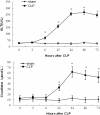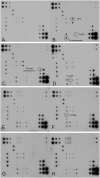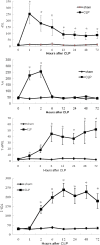Novel biomarkers for early prediction of sepsis-induced disseminated intravascular coagulation in a mouse cecal ligation and puncture model
- PMID: 23497204
- PMCID: PMC3637617
- DOI: 10.1186/1476-9255-10-7
Novel biomarkers for early prediction of sepsis-induced disseminated intravascular coagulation in a mouse cecal ligation and puncture model
Abstract
Introduction: The objective of this study was to identify biomarkers of sepsis-induced disseminated intravascular coagulation (DIC) among platelet-derived factors using biotin label-based custom protein microarray technology in a mouse cecal ligation and puncture (CLP) model.
Methods: KM mice were randomized into sham-operated and CLP groups. Blood samples were obtained immediately and at 1 h, 2 h, 6 h, 12 h, 24 h, 48 h and 72 h after establishment of the CLP for platelet count, coagulation assay and blood chemistry. Lung and mesentery tissues were examined histologically at all corresponding time points, looking for microthrombus formation. Serial protein microarray analysis was performed to detect platelet-derived factors.
Results: The survival rate 72 h post-CLP was 15%, but there was no mortality among the sham-operated mice. Compared with the sham group, the platelet count (n = 5, p < 0.05), fibrinogen concentration (n = 5, p < 0.05) and alanine aminotransferase level of the CLP group began to decrease significantly at 6 h post-CLP. Significant prolongation of prothrombin time (n = 5, p < 0.05) and activated partial thromboplastin time (n = 5, p < 0.05) and elevation of D-dimer (n = 5, p < 0.05) occurred after 6 h post-CLP. On histology, microthrombus formation in lung and mesentery tissue was observed in the CLP groups 6 h post-CLP and had become significant and extensive 12 h post-CLP (n = 5, p < 0.05). On protein microarray analysis and ELISA, thrombospondin (TSP), tissue inhibitor of metalloproteinase 1 (TIMP-1) and thymus chemokine-1 (TCK-1) all increased during the first 2 h post-CLP, then remained at a higher level than in the sham group for 72 h post-CLP (n = 5, p < 0.05).
Conclusions: TSP, TIMP-1 and TCK-1 are elevated in the early stage of sepsis-induced DIC in a mouse CLP model and may be considered early markers for sepsis-induced DIC.
Figures








References
-
- Jesús B, Arturo M-B, Víctor S, Francisco T, Francisco G, Luís T, Javier C, Ángel G-L, Demetrio C, Manuel V, Martín De F, María-Jesús L, Ana C, José G, Braulio Á, Agustín M, Jesús V. Incidence, organ dysfunction and mortality in severe sepsis: a Spanish multicentre study. Crit Care. 2008;12:R158. doi: 10.1186/cc7157. - DOI - PMC - PubMed
-
- Dellinger RP, Levy MM, Carlet JM, Bion J, Parker MM, Jaeschke R, Reinhart K, Angus DC, Brun Buisson C, Beale R, Calandra T, Dhainaut JF, Gerlach H, Harvey M, Marini JJ, Marshall J, Ranieri M, Ramsay G, Sevransky J, Thompson BT, Townsend S, Vender JS, Zimmerman JL, Vincent JL. Surviving Sepsis Campaign: international guidelines for management of severe sepsis and septic shock: 2008. Intensive Care Med. 2008;34(1):17–60. doi: 10.1007/s00134-007-0934-2. - DOI - PMC - PubMed
-
- Lever A, Mackenzie I. Sepsis: definition, epidemiology, and diagnosis. BMJ. 2007;335(7625):879–883. doi: 10.1136/bmj.39346.495880.AE. - DOI - PMC - PubMed
LinkOut - more resources
Full Text Sources
Other Literature Sources
Research Materials
Miscellaneous

